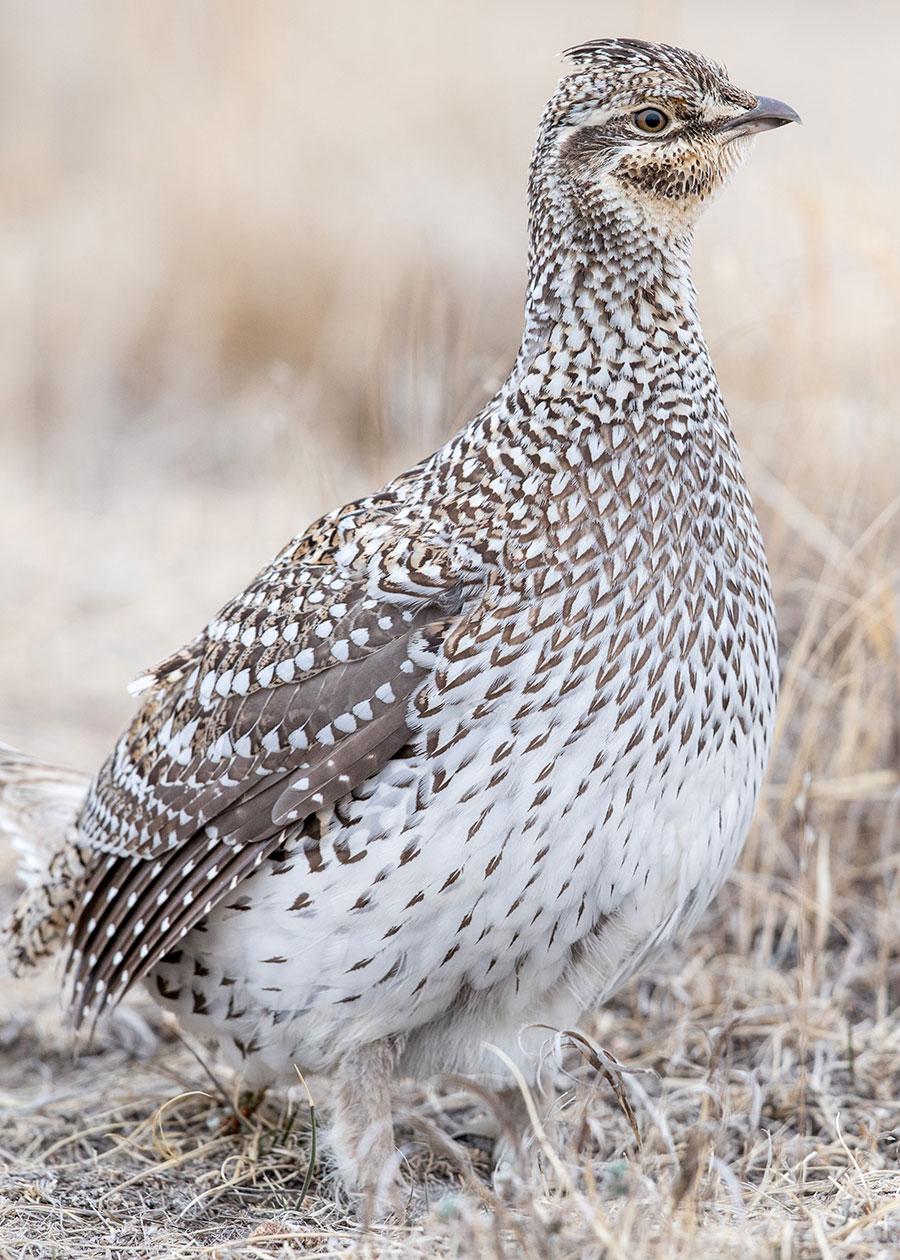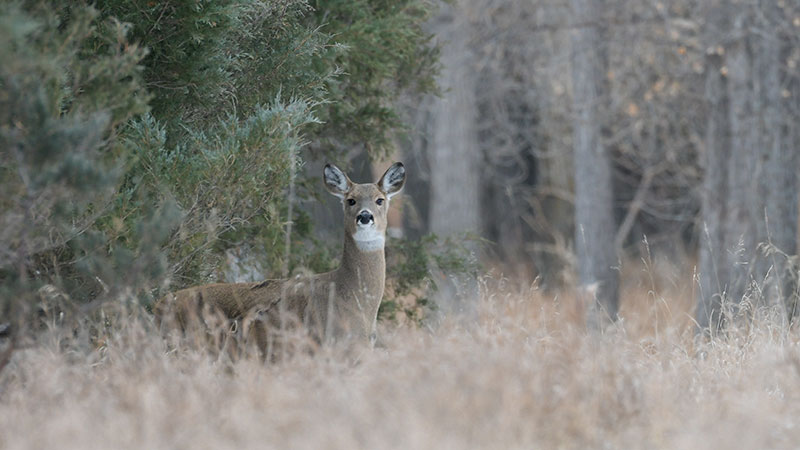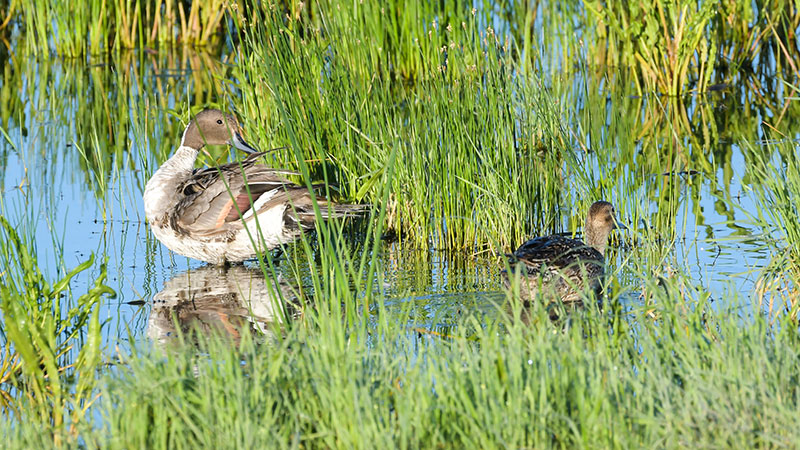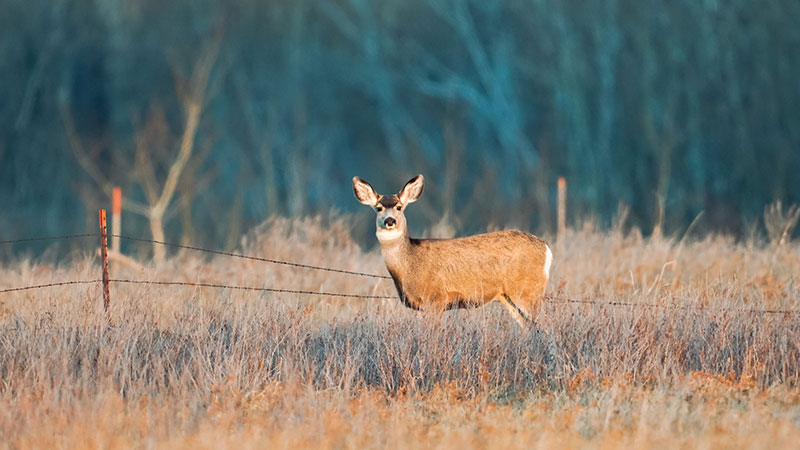2022 in Review
Various

Sharp-tailed Grouse
One of the factors that can have a huge impact on fish and wildlife resources in North Dakota is the weather. What’s particularly frustrating to fish and wildlife managers is that we obviously have no control over the one thing that can swing those populations either up or down in a big way.
We experienced a severe drought just a year ago, yet spring 2022 looked promising from a moisture standpoint, painting a much rosier picture for the future of our fish and wildlife resources. Lakes that experienced declining water levels were once again filled and the terrestrial habitat seemingly rebounded overnight. Unfortunately, some of that moisture came in the form of a couple of major spring blizzards. It was disheartening to learn about the loss of livestock because of those heavy, wet snows.
Drier conditions prevailed over much of the state after the late spring snows and rain, and we’re once again crossing our fingers for adequate moisture levels going into next spring.
Epizootic hemorrhagic disease is largely influenced by climatic factors and is just one example of something that can have a devasting effect on some of our localized deer herds. EHD is a fatal disease that mostly affects white-tailed deer and it impacted our whitetail herd in 2021 to a magnitude that we’d never seen. Significant die-offs occurred in areas of the state that rarely experience EHD. The region that was most affected appeared to center around the Missouri River corridor, but EHD was also verified in areas as far east as the Red River valley.
Fortunately, EHD was a non-issue in 2022 and our whitetail population has started to rebound in those areas most affected last year. While it may take a few years with favorable habitat conditions for those local whitetail populations to fully recover, it is encouraging that it’s at least moving in the right direction.
One of the positives worth reporting from 2022 is that, at least at the time of this writing, no new zebra mussel infestations were reported.
It’s also encouraging to hear reports of good numbers of pheasants and Hungarian partridge from certain areas across the state.
We’re often asked why there aren’t as many deer or pheasants in certain parts of the state as there were several years ago. The short answer is habitat. There just isn’t as much habitat on the landscape as, say, 10 or 15 years ago.
Like many of our constituents, we’d also like to see wildlife numbers similar to back then, but it’s unrealistic to expect that we’re going to be able to achieve that given the existing habitat base we have to work with.
On that front, we’re working on and tracking a few federal initiatives that will hopefully turn that trend around to a certain degree. While we normally tend to focus most of our energies on huntable/catchable species, some of these initiatives are aimed at the management and recovery of our state’s species of conservation priority. In North Dakota, there are currently 115 species that fit into that category. These are species like the Western meadowlark, our state bird, that are in decline and in need of some special attention to hopefully reverse downward population trends and begin moving the needle in their favor.
Most of these species are grassland dependent and so one of the recovery strategies will be to increase and improve grassland habitat in strategic locations with the goal of preventing these species from being listed on the threatened and endangered species list.
There will undoubtedly be some level of success with these initiatives over the next several years and, indirectly at least, many of the species we traditionally focus on will receive a shot in the arm from that as well.
SCOTT PETERSON is the Game and Fish Department’s deputy director.
Record Bighorn Sheep Tally
The North Dakota Game and Fish Department’s 2021 bighorn sheep survey, completed by recounting lambs in March 2022, revealed a record 335 bighorn sheep in western North Dakota, up 4% from 2020 and 15% above the five-year average. The count surpassed the previous record of 322 bighorns in 2020.
In total, biologists counted 99 rams, 175 ewes and 61 lambs. Not included were approximately 40 bighorn sheep in the North Unit of Theodore Roosevelt National Park and bighorns introduced to the Fort Berthold Indian Reservation in 2020.
This was the fourth consecutive year the survey saw an increase.
The northern badlands population increased 6% from 2020 and was the highest count on record. The southern badlands population declined again to the lowest level since bighorns were reintroduced there in 1966.
Biologists were encouraged to see the count of adult rams increase to near record levels, and adult ewes were at record numbers. Most encouraging was a record lamb count corresponding with a record recruitment rate.
Department biologists counted and classified all bighorn sheep in late summer, and then recounted lambs the following March as they approached one year of age to determine recruitment.
Department staff, in conjunction with biologists from the Three Affiliated Tribes Fish and Wildlife Division, also reported the bighorn sheep translocated in January 2020 from Rocky Boy’s Reservation in Montana to the Fort Berthold Reservation performed exceptionally well their second year in the state. The population nearly doubled in just two years, which is exceptional population performance for bighorn sheep.
It was estimated in 2022 that there were about 450 bighorn sheep among populations managed by the Game and Fish Department, National Park Service and Three Affiliated Tribes Fish and Wildlife Division. The next benchmark is 500 bighorns in the state, which seemed improbable just a few years ago.
The Department allocated five bighorn sheep licenses for the 2022 hunting season, the same as 2021.
Updated CWD Plan Unveiled
North Dakota Game and Fish Department officials held three public meetings in late summer in Fargo, Dickinson and Minot to update hunters and others about the status of chronic wasting disease in the state and how Game and Fish hopes to address the disease in the future.
A CWD task force of agency employees from several divisions was formed in 2021 to review the science of CWD, evaluate the status of CWD management in North Dakota, and chart a best path forward while folding in lessons across North America over decades.
The task force updated the Department’s CWD and surveillance plan, which was unveiled in 2022 at the public meetings. The updated plan for the always fatal disease to deer and other cervids that has found some footing in North Dakota and will forever remain on the landscape, will go into play in 2023.
CWD, caused by a prion protein that leads to irreversible damage to the nervous system, was first identified in North Dakota in mule deer in 2009 and white-tailed deer in 2013.
Department officials said the Game and Fish has tested more than 40,000 deer in the state for CWD in the last 20 years and followed the science and applied different tools for managing for CWD.
Yet here we are 20 years later, Department officials acknowledged, and it was time to stop and do a comprehensive reassessment of where they’re at and where they hope to go considering the certainty that chronic wasting disease is going nowhere and has the potential to significantly impact North Dakota’s big game populations if left unchecked.
Pheasants Up, Sharptails Down
North Dakota’s late summer roadside surveys indicated pheasant and Hungarian partridge were up from 2021, while sharp-tailed grouse numbers were down.
Department biologists said the annual late summer counts showed mixed results as they observed an increase in pheasant and partridge densities and reproductive rates with average brood size and age ratios, while sharptails decreased in density but had improved reproductive rates from 2021.
Total pheasants observed (49 per 100 miles) were up 9% from last year and broods (5.3) per 100 miles were up 8%. The average brood size (6.2) was up 7%.
Sharptail hunters were told to expect to find more hatch-year grouse in fall. The rangeland vegetation was significantly taller, and there were many more areas to search to find grouse than 2021 during the drought.
Sharptails observed per 100 miles were down 30% statewide. Brood survey results showed two sharptail broods and 13 sharptails per 100 miles. Average brood size was six.
Generally, most of the partridge harvest no matter the year is incidental while hunters pursue grouse or pheasants. But in 2022, with partridge numbers looking impressive, biologists indicated there might be pockets of birds where hunters could focus primarily on Huns.
Partridge observed per 100 miles were up 46%. Observers recorded one partridge brood and 12 partridge per 100 miles. Average brood size was 10. The last time partridge numbers looked this good was 2015.
Verbatim
“As somebody who’s from North Dakota, I want to see healthy prairie habitat. And I think rattlesnakes are one of the keys to doing that in central and western North Dakota,” said Matthew Smith, associate professor with North Dakota State University biological services department.
“In my time with the Department, I have heard a lot of different opinions on what should be done as wildlife populations have declined on the landscape … from changes to the deer lottery system, to access to wildlife on the landscape. However, if you look deep into these issues, the fixes suggested are more band-aid than a solution. The one thing that makes most of these issues go away is habitat, which can improve soil health, water quality, water quantity, and ultimately wildlife populations,” said Casey Anderson Department wildlife division chief.
“Quality of life, at least for those who hunt and fish, is taking advantage of a crisp fall morning chasing roosters, decoying waterfowl, sitting comfortably 12 feet up in your favorite tree, or wetting a line later in the day when the temperature hits that perfectly comfortable 60 degrees. Or perhaps a combination of some of these activities all in one day,” said Jeb Williams, Department director.
“The does are still putting on food reserves, but once they hit winter, they can’t really eat enough to gain any more weight. So, as the winter progresses, it’s kind of like a bucket with a hole in it. And the longer the winter is, the more severe the winter is, the more energy reserves are going to drain out of that bucket,” said Bill Jensen, Department big game management biologist.
“Knock on wood, but because of the high water this spring and the flooded vegetation at the right time, it appears to have produced a very strong yellow perch year-class throughout most of our waters. That will pay dividends to the angler three, four years from now, and maybe we’ll have a real resurgence in some quality perch lakes throughout the state,” said Greg Power, Department fisheries chief.
2022 Statistics
2021-22 Licenses and Permits Issued
| Type | Resident | Nonresident |
|---|---|---|
| Individual Fishing | 43,936 | 18,428 |
| Married Couple Fishing | 12,069 | 6,076 |
| Senior Citizen Fishing | 14,799 | |
| Disabled Fishing | 285 | |
| Short-Term Fishing 10-Day | 7,766 | |
| Short-Term Fishing 3-Day | 25,735 | |
| Paddlefish Tags | 2,811 | 631 |
| Commercial Tags | 10 | |
| Retail Bait Vendor | 220 | |
| Wholesale Bait Vendor | 32 | 3 |
| Fish Hatchery | 2 | |
| 2021 Boat Registrations (First year of 3-year decal) | 10,895 | |
| General Game Hunting | 42,802 | 41,282 |
| Small Game Hunting | 12,724 | 21,209 |
| Combination License | 63,801 | |
| Waterfowl Hunting | 23,062 | |
| Furbearer Hunting/Trapping | 6,564 | 2,716 |
| Fur Buyer | 26 | 8 |
| Deer Gun Hunting | 54,662 | 716 |
| Deer Gun Hunting (Gratis) | 11,803 | 301 |
| Deer Bowhunting | 26,238 | 3,501 |
| Moose Hunting | 401 | |
| Moose Hunting (Preferential Landowner) | 68 | |
| Elk Hunting | 445 | |
| Elk Hunting (Preferential Landowner) | 88 | |
| Turkey Hunting (Spring) | 7,266 | |
| Turkey Hunting (Fall) | 3,550 | |
| Turkey Hunting (Gratis Spring) | 568 | |
| Turkey Hunting (Gratis Fall) | 306 | |
| Habitat Stamp | 106,603 | |
| Shooting Preserve | 12 | |
| Fishing/Hunting Guide | 308 | 53 |
| Taxidermist | 287 | 7 |
| Falconry | 4 | |
| Scientific Collector | 28 | 34 |
| Swan | 1,413 | 787 |
| Sandhill Crane | 2,581 | 2,316 |
2022 Special Big Game Licenses
| Type | Licenses Available | Applications Received |
|---|---|---|
| Moose | 400 | 26,038 |
| Elk | 559 | 23,427 |
| Bighorn Sheep | 5 | 19,423 |
Financial Statement - July 1, 2021 to June 30, 2022
| Type | Amount |
|---|---|
| Income | $38,789,812 |
| Expenses | $38,366,692 |
Fund Balances, Fixed Assets and Long-term Debt
| Type | Amount |
|---|---|
| Game and Fish General Fund | $29,175,265 |
| Habitat and Depredation Fund | $4,165,907 |
| Nongame Wildlife Fund | $145,921 |
| Aquatic Nuisance Species Program | $110,205 |
| TOTAL ALL FUNDS | $33,597,299 |
| FIXED ASSETS | $58,207,479 |
| DEPARTMENT NET WORTH | $91,804,777 |
Other
- 2,639 Number of sharptailed grouse counted on spring dancing grounds, down from 3,281 in 2021.
- 22% The decline in roosters heard crowing during the Department’s spring pheasant crowing count compared to 2021.
- 800,000 Approximate number of PLOTS acres on the landscape in 2022.
- 81,000 Number of Canada geese counted during the Department's midwinter waterfowl survey.
- 7.4 million Number of private land acres electronically posted.
- 1.8 million Approximate number of chinook salmon eggs collected during the Department's annual salmon spawn.
- 60 lbs. 8 oz Weight of new bow/spear state record buffalo taken by Mitch Estabrook from Heart Butte Reservoir.
- 70 million Approximate number of walleye eggs collected in spring, surpassing the goal of 58 million eggs




